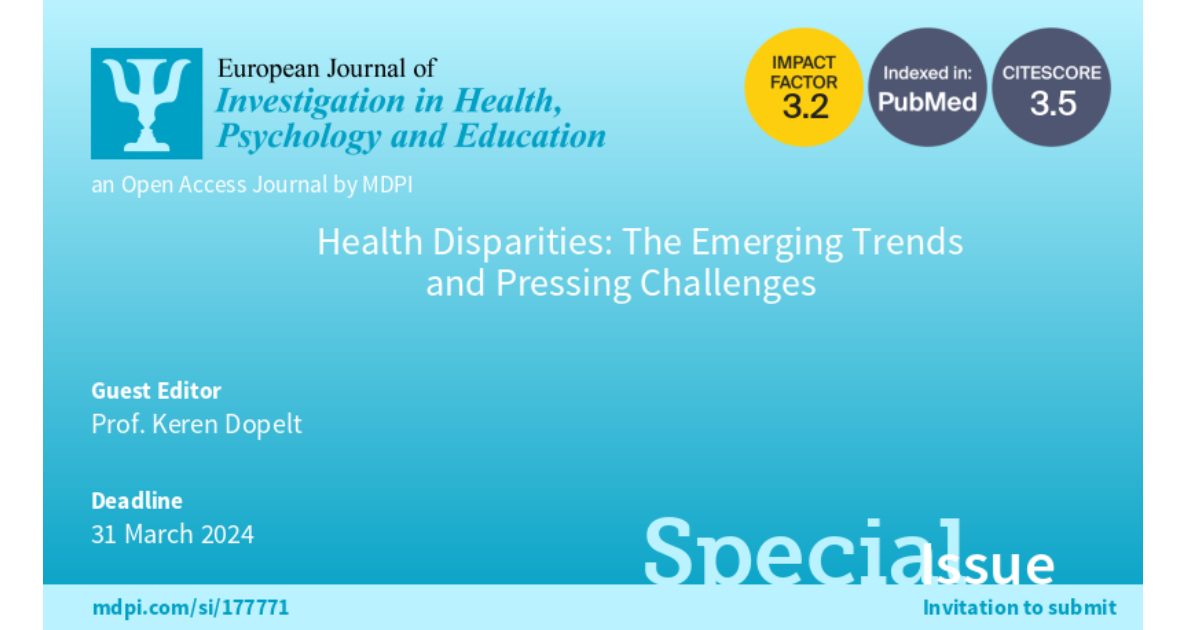Health Disparities: The Emerging Trends and Pressing Challenges
A special issue of European Journal of Investigation in Health, Psychology and Education (ISSN 2254-9625).
Deadline for manuscript submissions: closed (31 March 2024) | Viewed by 12670

Special Issue Editor
Interests: health disparities; health promotion & education; health policy; sociology of health
Special Issues, Collections and Topics in MDPI journals
Special Issue Information
Dear Colleagues,
The Centers for Disease Control and Prevention (CDC) defines health disparities as “preventable differences in the burden, disease, injury, violence, or in opportunities to achieve optimal health experienced by socially disadvantaged racial, ethnic, and other population groups and communities”.
Health disparities have a profound influence on communities and individuals, shaping their overall health, wellbeing, and social dynamics. Health disparities are often deeply rooted in societal inequities related to factors such as race, ethnicity, socioeconomic status, education, and access to resources. Health disparities contribute to unequal health outcomes, reduced community resilience, a lack of trust and cooperation, a burden on community resources, and disruption of wellbeing. Addressing health disparities requires a community-centered approach that involves collaboration between governments, healthcare providers, community organizations, policymakers, and individuals. By promoting health equity, improving access to healthcare, and addressing social determinants of health, communities can work towards reducing health disparities and creating healthier environments for all residents. While it is true that there have been increasing efforts to address health disparities in recent years, the persistence and complexity of these disparities present ongoing challenges. Continued research, data collection, and evaluation are essential to inform effective strategies and monitor progress in reducing health disparities.
The aim of this Special Issue is to raise awareness about the existence, magnitude, and impact of health disparities within specific populations or across various dimensions such as race, ethnicity, socioeconomic status, gender, or geographic location, to explore and deepen the understanding of the determinants of health disparities and to inform and influence policy development and healthcare practice.
Prof. Keren Dopelt
Guest Editor
Manuscript Submission Information
Manuscripts should be submitted online at www.mdpi.com by registering and logging in to this website. Once you are registered, click here to go to the submission form. Manuscripts can be submitted until the deadline. All submissions that pass pre-check are peer-reviewed. Accepted papers will be published continuously in the journal (as soon as accepted) and will be listed together on the special issue website. Research articles, review articles as well as short communications are invited. For planned papers, a title and short abstract (about 100 words) can be sent to the Editorial Office for announcement on this website.
Submitted manuscripts should not have been published previously, nor be under consideration for publication elsewhere (except conference proceedings papers). All manuscripts are thoroughly refereed through a single-blind peer-review process. A guide for authors and other relevant information for submission of manuscripts is available on the Instructions for Authors page. European Journal of Investigation in Health, Psychology and Education is an international peer-reviewed open access monthly journal published by MDPI.
Please visit the Instructions for Authors page before submitting a manuscript. The Article Processing Charge (APC) for publication in this open access journal is 1400 CHF (Swiss Francs). Submitted papers should be well formatted and use good English. Authors may use MDPI's English editing service prior to publication or during author revisions.
Keywords
- health disparities and health inequality locally and globally
- health justice and distributive justice
- food insecurity
- public vs. private health insurance
- health of immigrants, minorities, LGBTQ
- racism/ethnicity/diversity
- health services utility among marginalized and vulnerable populations
- public health policy
- health workforce and services in peripheral areas
- social determinants of health
Benefits of Publishing in a Special Issue
- Ease of navigation: Grouping papers by topic helps scholars navigate broad scope journals more efficiently.
- Greater discoverability: Special Issues support the reach and impact of scientific research. Articles in Special Issues are more discoverable and cited more frequently.
- Expansion of research network: Special Issues facilitate connections among authors, fostering scientific collaborations.
- External promotion: Articles in Special Issues are often promoted through the journal's social media, increasing their visibility.
- e-Book format: Special Issues with more than 10 articles can be published as dedicated e-books, ensuring wide and rapid dissemination.
Further information on MDPI's Special Issue polices can be found here.






